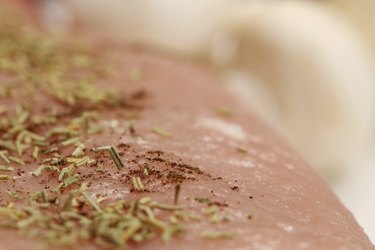
Many herbs complement the mild, savory flavor of pork tenderloin, helping you adapt the tenderloin to a broad range of flavors and cuisines. Consider the other ingredients in your tenderloin recipe or the seasoning in side dishes when you select herbs for the pork. A grilled tenderloin topped with a fruit salsa or glaze may benefit from different seasonings than a tenderloin stuffed with mushrooms and spinach. Offset each strong herb with a milder, complementary herb if you prepare a seasoning blend.
Seasoning With Sage
Video of the Day
Sage is a strong, slightly peppery herb common to British, American and Northern-Italian cuisine. Pork sausages typically contain sage, and stuffing recipes often include it. Many people associate it with rich foods and autumnal dishes. It complements squash, spinach, onions, root vegetables, apples, citrus, cheese and nuts. Use sage alone or in a blend with rosemary, thyme, bay leaves or parsley.
Video of the Day
Rocking With Rosemary
Rosemary is a strong, woodsy herb common to Italian, American and French cuisine. It is common in herb breads and potato dishes. It complements mushrooms, onions, garlic, potatoes, citrus and cheese, especially Parmesan. Use rosemary alone or in a blend with thyme, sage, bay leaves, oregano, marjoram or basil.
Taking Up Thyme
Thyme is a moderately strong, earthy herb common to French, American and Italian cuisine. It has subtle pepper and lemon flavors. It complements most vegetables as well as cherries, figs, citrus and cheese. Use thyme in a blend with sage, rosemary, bay leaves, oregano, marjoram or basil.
Betting on Bay Leaves
Bay leaves have a bitter, woodsy taste. They are used in American, Italian, Greek, French, Indian and Middle Eastern cuisine. Bay leaves release flavor more effectively in liquid, so flavor a sauce, glaze or braising liquid with them. Discard the leaves before serving the tenderloin as consuming them can cause digestive discomfort. Bay leaves complement potatoes, tomatoes, root vegetables and mushrooms. Use them with sage, rosemary, thyme, oregano or marjoram.
Mixing Oregano and Marjoram
Oregano and marjoram are closely related herbs and have similar earthy flavors. They are common to Italian, American, Mexican, Greek and Middle Eastern cuisine. Oregano has a slightly stronger, more bitter flavor than marjoram, which is more delicate and sweet. They complement most vegetables, tomatoes, citrus and cheese. Blend oregano and marjoram together or with rosemary, thyme, bay leaves or basil.
Blending With Basil
Basil is a moderately strong, peppery herb common to Italian, American and French cuisine. Sweet basil is the variety easiest to find in the U.S. marketplace. It complements tomatoes exceptionally well. It also enhances onion, garlic, squash, peppers, figs, citrus and cheese. Blend basil with rosemary, thyme, oregano or marjoram.
Choosing Cilantro
Cilantro is the leafy part of a coriander plant. It is common to Mexican, American Tex-Mex, Indian and Vietnamese cuisine. It has a biting flavor with lemon and pepper undertones. The pungent green flecks of minced herb in Tex-Mex salsas and pico de gallo are cilantro. It complements a curried pork dish or a grilled pork tenderloin that includes a tomato- or fruit-based salsa. Use it alone or blend it with Mexican oregano.
Cooking Considerations
Always add delicate basil and cilantro at the end of cooking unless they are in the filling of a stuffed pork tenderloin. Even heartier, woodsy herbs char and become bitter on the surface of a pork tenderloin cooked with direct, dry heat. Periodically baste a grilled or broiled tenderloin or apply a light coat of olive oil to the surface to protect exposed seasoning. Herbs in a stuffed pork tenderloin are protected by the meat and other stuffing ingredients, so it is safe to cook them without taking additional precautions as long as you cook the tenderloin correctly.